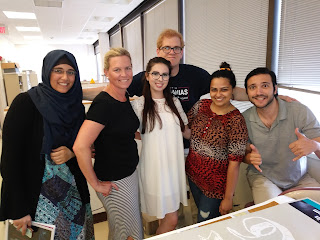We kicked off the week with some wrap up for our previous project using BIOPAC. We ended up with a total of 16 subjects and we may be able to maneuver the data into one conclusion or another, but our main focus has been on what is yet to come.
This is Professor DiLauro hooked up to the Atlantis. The Atlantis interfaces with software named BrainAvatar for the purposes of administering neuro-feedback trainings. Neuro-feedback is a burgeoning technique that focuses on autonomic regulation. That monitor displayed "Little Miss Sunshine," a film vaguely about beauty pageants, and the brightness changed according to Professor DiLauro's brain waves. In addition, tones in a diatonic scale played in response to the professor's brainwaves. The result is a surprisingly profound effect on wakefulness and mood. This paradigm is the infra-slow fluctuation training exhibited during the seminar that took place before Summer I began.
We are beginning work on furnishing one of the old x-ray rooms in the dental hygiene clinic to transform it into a therapeutic, sleek, and effective place for our research to take place. Unfortunately, the room was unavailable for a picture due to not having her makeup on.
It's kind of a mess right now. Check back next week.
Sadik E. has been drafted to help us with digitizing some forms and being generally awesome at everything. We acquired a Raspberry Pi and a new monitor for Sadik to begin work that will undoubtedly assist us in achieving the necessary level of privacy and ergonomic fu.
I'm not going to lie, most of our work this week was creating documents.
Documents. Documents. Intakes, anxiety measures, consents, sign up sheets, flyers, the sixth thing.

Seriously, we made like 20 different documents this week.
We are hoping to receive an Atlantis and the BrainAvatar software on loan so that we can begin to administer the ISF trainings. Also, we are going to borrow qEEG equipment so that we might determine the power of the trainings. Jackie De Vries would be our source, and she is at the Crossroads clinic by route 17 on Linwood avenue.
The last thing is that we are going to have to overhaul our IRB form and our research proposals to accommodate all of these changes. We learned that we have a loooooooooot of work to do.
Here are some more pictures. Cheers!



















































